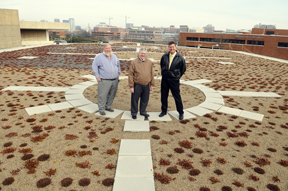Patti Hurley is intrigued by the possibilities of a green roof. She specifically wants to know the benefits green roofs can have for their surrounding environment, something not studied in great detail for an extended period of time.
 |
| (From left to right) Roofing Specialist Roger Brown, Environmental Engineering Professor Robert Peters and Energy Manager Matt Winslett have helped make UAB’s first green roof a success. |
“He told me he was shipping plants to Alabama the next week, and I was floored,” she says. “I said, ‘You are? Where are you sending them?’”
UAB Facilities energy management department was building UAB’s first green roof atop the Hulsey Center Building, and the plants were being sent here.
Hurley contacted Energy Manager Matt Winslett to schedule a time to visit and see the roof for herself. Now, ADEM is interested in learning more about the green roof’s benefits — and in promoting it throughout the state.
“We had been wanting to get somebody to put in a green roof, and nobody wanted to do it because nobody else had done it in Alabama,” says Hurley, who works in the non-point source pollution section of ADEM. “When I saw what they had done, I was so proud they had been researching green roofs. I want to use them as an example as the first institution in Alabama to do it.”
Hurley and ADEM are interested in learning more about the benefits of the green roof to curb the amount of pollutants that reach the storm sewer and ultimately flow to rivers, streams and lakes.
Robert Peters, Ph.D., professor of environmental engineering, is studying the reduction stormwater runoff and the impact the green roof has on the release of nitrates and phosphates into the environment.
“We’ve submitted two proposals to better quantify the nitrates and phosphates, and we’ve teamed with the biology department to help with plant selection and stormwater mitigation,” Peters says. “We’re excited about the direction the project is heading and learning more about how the vegetated roof can reduce these pollutants.”
Reducing pollutants
When it rains, anything that is on the ground, rooftop or road is washed into storm drains. Urban areas are more prone to flooding, and the floodwaters that go into the storm drain carry those pollutants to the river.
The pollutants can range from metals to pathogens to fertilizers.
“We humans have practices, and we don’t realize when it rains some of those things are going to affect our water quality,” Hurley says. “Many people don’t understand that water that runs into the storm sewer does not go through a treatment plant. It goes directly to the creeks and rivers.”
“The reason we were interested in the green roof is that we pay for and bring in best-management practices that will abate the pollution that’s in our stormwater runoff,” Hurley says.
When the pollutants reach the rivers, streams and lakes it leads to eutrification — a result of nutrient pollution, such as the release of sewage, urban stormwater run-off and run-off carrying excess fertilizers — and algae growth.
Peters has teamed with Stephen Watts, Ph.D., professor of biology, and his doctoral student Julie Price to help identify the optimal plant species to use in the Southeast. The soil matrix and plant-systems structure will determine the amount of nitrates and phosphates a green roof produces.
“If you can get by with minimal amounts of fertilizer applications, then that shouldn’t be a problem,” Peters says.
Roger Brown, UAB’s roofing specialist, designed the Hulsey Center roof. It has several layers under the autoclave aerated concrete, including a polypropolene-type liner, a Styrofoam-type insulation and a plastic that looks like an egg carton. It can hold 6,000 gallons of water, and it is designed to catch the rainwater and delay its release to minimize the potential for flooding.
“Imagine the possibilities if many other downtown buildings had green or vegetative roofs,” Brown says. “If they perform the way they are supposed to, it could help mitigate flooding.”
Energy savings
UAB also is interested in studying another benefit the roof can provide — energy savings.
Peters has compared natural gas, water and electricity bills for the Hulsey Building four years prior to the green roof installation in July 2008 and the subsequent 18 months. Cost savings are between 20 and 25 percent.
“It’s really almost too good to be true,” Winslett says.
Facilities expected to see some relief in utility bills from the green roof and also instituted other energy-efficiencies, but they did not expect those to have such a significant impact.
“The roof has contributed to these decreases, but we’re surprised it’s been as much as it’s been,” Winslett says.
Peters continues to research the data and is optimistic that the best performance of the roof is yet to come.
“It’s not yet an optimized system,” Peters says. “We haven’t selected the best plant species yet. We think the roof has great potential.”